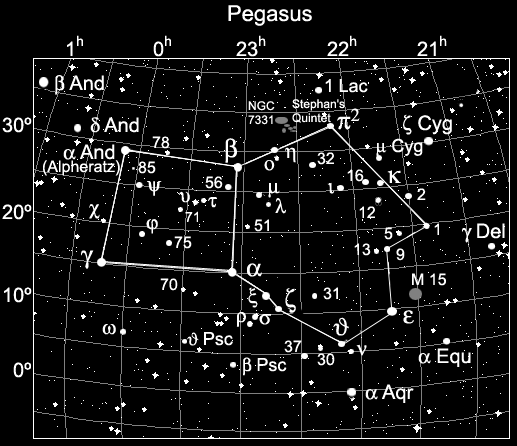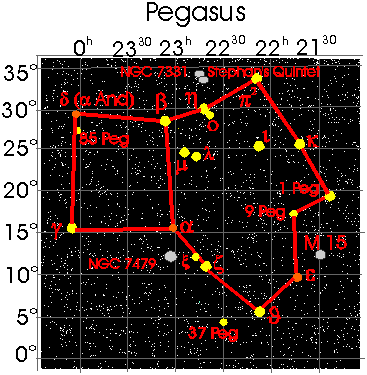
Pegasus is the winged-horse which sprung from the blood of the slain Medusa, killed by Perseus. Pegasus' father was Poseidon, God of the Sea. This autumnal constellation has some fine objects for telescopes, and a few for binoculars as well, such as M15, a splendid globular cluster. The constellation is 'joined' with Andromeda as the common star Alpheratz serves not only as alpha Andromedae but also as delta Pegasi. The Great Square of Pegasus, one of Autumn's notable signs, is first seen in mid-Summer if you face the east around 1 a.m. It'll be found between Deneb and the horizon, standing on one of its corners (gamma Peg).

Alpha Pegasi is Markab, ‘saddle’. The 2.5 magnitude star forms the southwest corner of the 'Great Square of Pegasus', easiest to find with the naked eye. This Great Square is formed by delta Pegasi (Alpheratz) to the northeast, Scheat (beta Pegasi) to the northwest, Markab to the southwest, and Algenib (gamma Pegasi) to the southeast. The stars are all about ten degrees apart, just wide enough a separation not to be able to include even two members in the same FOV. Thus the naked eye is the best way to see it. The square first appears in mid-summer, between Deneb and the horizon. If you look due east early in the wee hours you'll find it standing tilted on gamma with Scheat to the north of it. By the second week in September the square has righted itself and is found due south around midnight. Markab is about ten degrees southwest of delta Pegasi. Now if you move to the west-southwest the same distance from delta Pegasi to alpha you'll encounter the brightest star in Pegasus, epsilon.
Delta Pegasi is rarely called ‘delta’ since it also goes by the name of alpha Andromedae (Sirrah or Alpheratz). The star forms the northeastern corner of The Great Square of Pegasus. In the same region is the famous binary 85 Pegasi, with a very rapid orbit of 26.3 years, needing a large telescope to resolve the companion (currently at a separation of 0.7" and PA of 180º, due south of the primary).
Epsilon Pegasi is Enif, ‘the nose’, an irregular variable supergiant with a usual magnitude of about 2.4 but which may brighten up to around 0.7 or dim to about 3.5. At a usual magnitude of 2.4 it's the brightest star in the constellation. The star is roughly midway between two alphas: east of Altair (tip of the Summer Triangle) and west of alpha Pegasi. Northwest of epsilon, in the same FOV, is M15, a very bright globular cluster perhaps visible to the naked eye but nicely seen in binoculars. Medium-sized telescopes resolve individual members.
